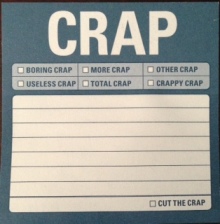We’ve all heard the expression: there are no bad ideas.
And you know something? That is just. not. true.
There are some awful ideas out there. Real stinkers. But many times absolutely ridiculous-sounding, bottom of the barrel sludge can become the creative equivalent of a vaccine – a moldy concept that sparks a creative cure.
Bad judgment, on the other hand, is very different. It’s a combination of arrogance and stupidity. And it’s on the rise. Just look at the proliferation of social media crises.
The trouble is, bad ideas and bad judgment are too often confused – especially in brainstorms.
Bad judgment can bring down a room
A few years back, we had a client who had a small Canadian budget for a PR launch. We were brainstorming ideas about what we could do and someone blurted out, let’s get Julia Roberts as a spokesperson.
I said, you mean someone like Julia Roberts, knowing our budget wasn’t enough to cover a three-minute call with her agent. But this person was adamant – no, it had to be Julia Roberts and because she couldn’t get past that, we had to stop the meeting and reschedule it (with the proviso that you couldn’t bring previously submitted ideas to the table, just so we wouldn’t get derailed again).
Was Julie Roberts a bad idea? Not really. If – and it’s a big if – we had a Hollywood spokesperson budget. But we didn’t!
Was it bad judgment? Absolutely, because the actress wasn’t there as a thought-starter, she was the final answer. And the person who suggested her couldn’t let it go.
So how can you have a brainstorm that’s open to bad ideas but keeps bad judgment at bay?
Here are three tips:
Make it a creative experience. Don’t simply bring colleagues to another around-the-bored-table meeting that’s differentiated only by its colourful post-it notes. Transport them to the world you’re trying to create. Come up with a concept, set the stage and host it somewhere they’d never expect (i.e. get them out of the office!). Wow them with a little magic, excitement and sense of serendipity. Because if you do, they’ll leave their deadlines and anxieties at the door and perform.
Ban egocentrics. They’re counter-productive. You know, the people who talk louder and more often than anyone else and sulk if they feel their ideas aren’t rising to the top of the heap. They claim they’re creative. But creative people don’t always have to be difficult to come up with crazy-good ideas. Until these folks learn to behave, suggest they submit their thoughts by email. And while you’re at it, turn down the volume on negativity, too – as in banishing people who have nothing to add and just bash what’s on the table in order to be heard.
Set the bar high and low. I always try to come up with the worst possible ideas in a brainstorm – and most times succeed. I do this to help the rest of the people in the room lose their self-consciousness and contribute things they might otherwise filter out. You never know where you’re going to find that diamond in the rough.
The thing to remember is some ideas are pretty awful. That’s OK, as long as bad ideas don’t turn into bad judgment.
Do you have any creative gems to add? Speaking of which, here are a few tips to unlock creativity.


I have a really bad idea, You should run Blanche Bloodget for PM. I think should would win by a landslide That is if you can find her, I may have a clue, Martin, you can readh me at arothchild1000@yahoo,com